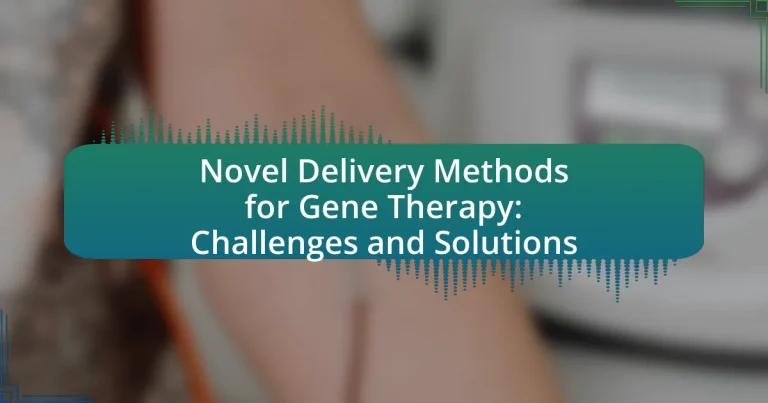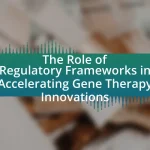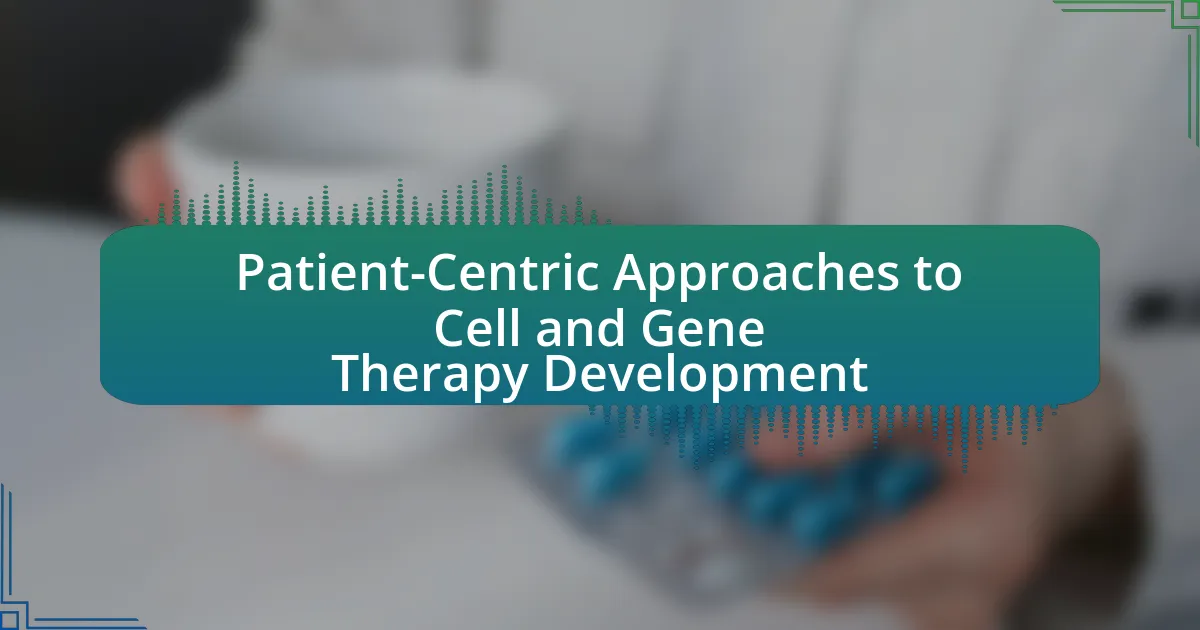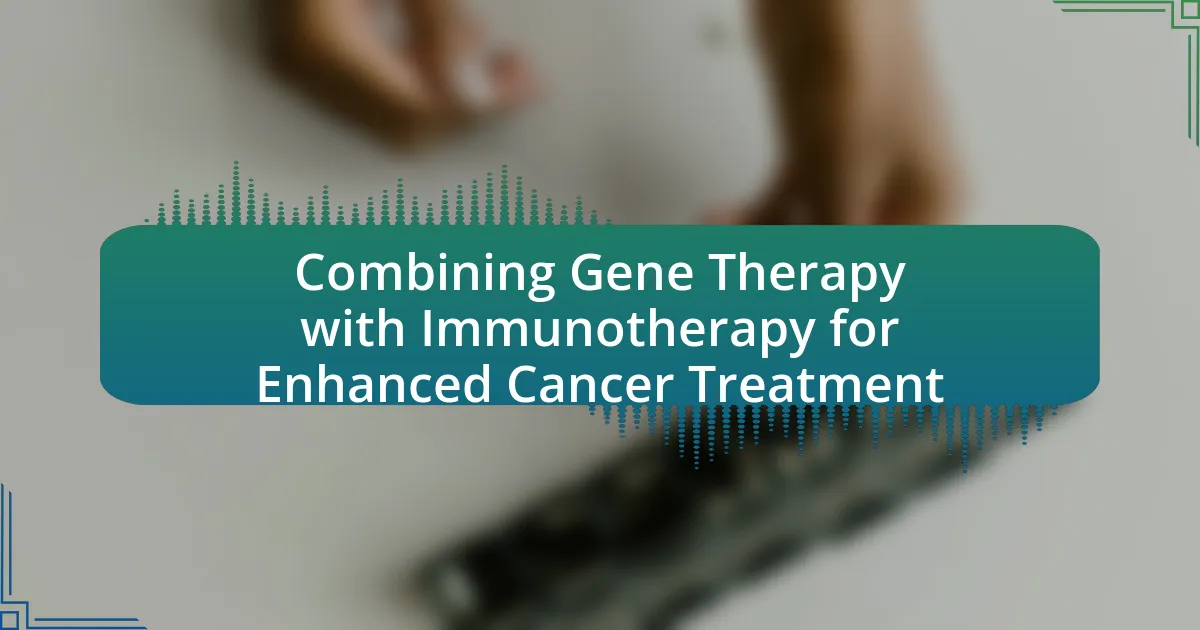Novel delivery methods for gene therapy, including viral vectors, nanoparticles, and electroporation, represent significant advancements in the field, enhancing the precision and efficacy of genetic treatments. These methods differ from traditional approaches by improving safety and reducing immune responses, while also addressing challenges such as targeting specificity and delivery efficiency. The article explores the characteristics, benefits, and challenges of these innovative delivery systems, as well as the regulatory hurdles and technical limitations faced in their development. Additionally, it highlights best practices for implementation and the potential long-term implications for patient outcomes in gene therapy.
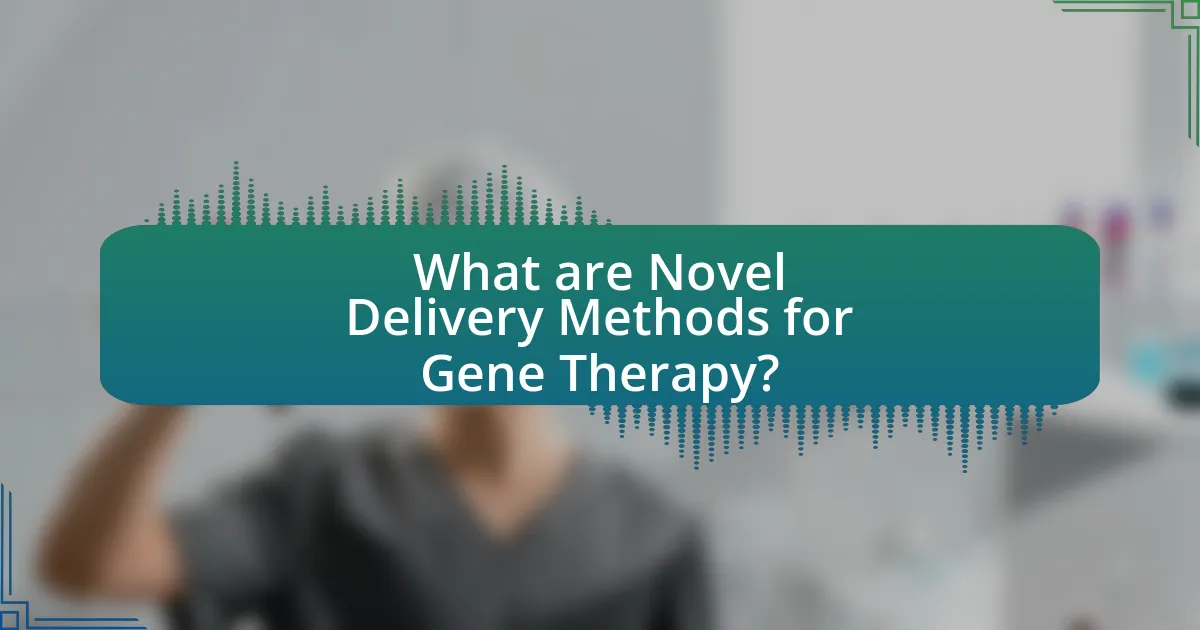
What are Novel Delivery Methods for Gene Therapy?
Novel delivery methods for gene therapy include viral vectors, nanoparticles, and electroporation. Viral vectors, such as lentiviruses and adeno-associated viruses, are engineered to deliver genetic material into target cells effectively. Nanoparticles, including lipid nanoparticles and polymer-based carriers, facilitate the transport of DNA or RNA across cellular membranes, enhancing uptake and expression. Electroporation uses electrical pulses to create temporary pores in cell membranes, allowing for direct entry of genetic material. These methods are supported by research demonstrating their efficacy in preclinical and clinical settings, such as the successful use of adeno-associated viruses in treating inherited retinal diseases.
How do these delivery methods differ from traditional approaches?
Novel delivery methods for gene therapy differ from traditional approaches primarily in their mechanisms and efficiency. Traditional methods often rely on viral vectors to deliver genetic material, which can pose risks such as immunogenicity and limited payload capacity. In contrast, novel methods, such as lipid nanoparticles and electroporation, utilize non-viral techniques that enhance delivery efficiency and reduce immune responses. For example, lipid nanoparticles can encapsulate mRNA and facilitate cellular uptake without the risks associated with viral vectors, as demonstrated in the successful deployment of mRNA vaccines during the COVID-19 pandemic. This shift towards non-viral delivery systems represents a significant advancement in gene therapy, allowing for safer and more effective treatment options.
What are the key characteristics of novel delivery methods?
Novel delivery methods for gene therapy are characterized by their ability to enhance specificity, efficiency, and safety in targeting cells. These methods often utilize advanced technologies such as nanoparticles, viral vectors, and electroporation to facilitate the precise delivery of genetic material. For instance, nanoparticles can encapsulate DNA or RNA, protecting it from degradation and allowing for controlled release at the target site. Additionally, viral vectors are engineered to improve transduction efficiency while minimizing immune responses. The use of these innovative approaches has been shown to increase therapeutic efficacy, as evidenced by clinical trials demonstrating improved outcomes in genetic disorders.
How do these methods enhance gene therapy effectiveness?
Novel delivery methods enhance gene therapy effectiveness by improving the precision and efficiency of gene transfer to target cells. Techniques such as nanoparticles, viral vectors, and electroporation facilitate better cellular uptake and expression of therapeutic genes. For instance, nanoparticles can protect genetic material from degradation and enable targeted delivery, while viral vectors can efficiently introduce genes into host cells due to their natural infection mechanisms. Studies have shown that these methods can significantly increase transfection rates and reduce off-target effects, leading to more successful therapeutic outcomes.
What are the main types of novel delivery methods?
The main types of novel delivery methods for gene therapy include viral vectors, non-viral vectors, and physical methods. Viral vectors, such as lentiviruses and adenoviruses, are engineered to deliver genetic material into target cells effectively. Non-viral vectors, including liposomes and nanoparticles, offer advantages like reduced immunogenicity and easier production. Physical methods, such as electroporation and microinjection, utilize physical forces to facilitate the entry of genetic material into cells. These methods are critical in overcoming challenges associated with gene therapy, such as efficient delivery and targeted expression of therapeutic genes.
What is the role of viral vectors in gene therapy delivery?
Viral vectors play a crucial role in gene therapy delivery by serving as vehicles to transport therapeutic genes into target cells. These vectors, derived from viruses, are engineered to be safe and effective, allowing for the precise introduction of genetic material into the host’s genome. For instance, adenoviruses and lentiviruses are commonly used due to their ability to infect a wide range of cell types and facilitate stable gene expression. Studies have shown that viral vectors can achieve high transduction efficiency, which is essential for the success of gene therapy interventions, as evidenced by clinical trials demonstrating significant therapeutic effects in conditions like spinal muscular atrophy and certain genetic disorders.
How do non-viral methods compare to viral vectors?
Non-viral methods generally offer advantages over viral vectors in terms of safety, scalability, and ease of production. Non-viral methods, such as liposomes, nanoparticles, and electroporation, do not carry the risk of insertional mutagenesis associated with viral vectors, which can lead to unintended genetic alterations. Additionally, non-viral methods can be produced in larger quantities and are often less expensive, making them more accessible for widespread use in gene therapy. For instance, a study published in “Molecular Therapy” by Zhang et al. (2020) demonstrated that lipid nanoparticles could effectively deliver mRNA with a lower immunogenic response compared to viral vectors. This evidence supports the assertion that non-viral methods can be safer and more practical alternatives in gene therapy applications.
What challenges do novel delivery methods face?
Novel delivery methods for gene therapy face significant challenges, including targeting specificity, delivery efficiency, and safety concerns. Targeting specificity is crucial as these methods must accurately deliver therapeutic genes to the intended cells without affecting healthy tissues, which can lead to unintended side effects. Delivery efficiency is another challenge, as many novel methods struggle to achieve sufficient uptake of genetic material into target cells, limiting their therapeutic effectiveness. Safety concerns arise from potential immune responses or toxicity associated with certain delivery vectors, such as viral carriers. These challenges are supported by research indicating that improving specificity and efficiency remains a primary focus in the development of gene therapy delivery systems, as highlighted in studies published in journals like Nature Biotechnology and Molecular Therapy.
What are the technical challenges in developing these methods?
The technical challenges in developing novel delivery methods for gene therapy include ensuring efficient and targeted delivery of genetic material, overcoming immune responses, and achieving stable expression of the therapeutic gene. Efficient delivery is critical because many delivery systems, such as viral vectors, face limitations in transfection efficiency and specificity to target cells. Immune responses can lead to rapid clearance of the therapeutic agents, reducing their effectiveness; for instance, adenoviral vectors can provoke strong immune reactions that hinder treatment outcomes. Additionally, achieving stable expression of the therapeutic gene is challenging due to potential integration issues and the variability in gene expression levels across different cell types. These challenges necessitate ongoing research and innovation in delivery technologies to enhance the efficacy and safety of gene therapies.
How do regulatory hurdles impact the adoption of novel delivery methods?
Regulatory hurdles significantly impede the adoption of novel delivery methods for gene therapy by creating lengthy approval processes and stringent compliance requirements. These regulatory frameworks often require extensive preclinical and clinical data to demonstrate safety and efficacy, which can delay the introduction of innovative therapies into the market. For instance, the U.S. Food and Drug Administration (FDA) mandates rigorous testing protocols that can take years to complete, thereby slowing down the pace at which new delivery methods are developed and implemented. Additionally, the uncertainty surrounding regulatory pathways can deter investment and innovation in the field, as companies may be hesitant to allocate resources to projects with unclear approval timelines.
What solutions are being explored to overcome these challenges?
Solutions being explored to overcome challenges in novel delivery methods for gene therapy include the development of advanced viral vectors, lipid nanoparticles, and electroporation techniques. Advanced viral vectors, such as adeno-associated viruses (AAVs), are engineered to enhance specificity and reduce immune responses, improving therapeutic efficacy. Lipid nanoparticles are being optimized for their ability to encapsulate mRNA and deliver it effectively to target cells, as demonstrated in recent mRNA vaccine technologies. Electroporation techniques are being refined to facilitate the uptake of genetic material into cells by applying electrical pulses, which has shown promise in preclinical studies. These approaches are supported by ongoing research that highlights their potential to address the limitations of traditional gene delivery systems.
How are researchers addressing technical limitations?
Researchers are addressing technical limitations in gene therapy by developing advanced delivery systems that enhance the efficiency and specificity of gene transfer. For instance, the use of nanoparticles and viral vectors has been shown to improve the targeting of specific tissues, thereby increasing the therapeutic efficacy while minimizing off-target effects. Studies, such as those published in “Nature Biotechnology,” demonstrate that lipid nanoparticles can effectively deliver mRNA to cells, overcoming barriers associated with traditional delivery methods. Additionally, researchers are exploring CRISPR technology to refine gene editing processes, which has been validated in clinical trials for its precision and reduced risk of unintended mutations. These innovative approaches collectively aim to overcome the challenges posed by existing delivery methods in gene therapy.
What role do collaborations play in overcoming regulatory challenges?
Collaborations play a crucial role in overcoming regulatory challenges by pooling expertise and resources from multiple stakeholders, including researchers, industry leaders, and regulatory bodies. These partnerships facilitate knowledge sharing, which helps in understanding complex regulatory frameworks and developing compliant strategies. For instance, collaborations can lead to the creation of standardized protocols that align with regulatory requirements, thereby streamlining the approval process for novel gene therapy delivery methods. Additionally, joint efforts often result in comprehensive data generation that addresses safety and efficacy concerns, which are critical for regulatory submissions.

How do Novel Delivery Methods Impact Patient Outcomes?
Novel delivery methods significantly enhance patient outcomes by improving the efficacy and safety of gene therapies. These innovative techniques, such as lipid nanoparticles and viral vectors, facilitate targeted delivery of therapeutic genes, leading to higher expression levels in the desired tissues. For instance, studies have shown that lipid nanoparticles can increase the bioavailability of mRNA vaccines, resulting in a more robust immune response, as evidenced by the rapid development and deployment of mRNA vaccines during the COVID-19 pandemic. Additionally, advancements in delivery methods can reduce off-target effects and associated adverse reactions, thereby improving overall patient safety and treatment adherence.
What are the potential benefits for patients using these methods?
The potential benefits for patients using novel delivery methods for gene therapy include improved efficacy, targeted treatment, and reduced side effects. Improved efficacy arises from advanced techniques that enhance the precision of gene delivery, ensuring that therapeutic genes reach the intended cells more effectively. Targeted treatment minimizes damage to healthy tissues, as these methods can be designed to focus on specific cell types, thereby increasing the likelihood of successful outcomes. Additionally, reduced side effects result from the ability to deliver lower doses of therapeutic agents directly to affected areas, which decreases systemic exposure and associated adverse reactions. These benefits are supported by studies demonstrating enhanced therapeutic outcomes and safety profiles in clinical trials involving innovative gene delivery systems.
How do novel delivery methods improve treatment precision?
Novel delivery methods improve treatment precision by enabling targeted delivery of therapeutic agents directly to affected cells or tissues. This targeted approach minimizes off-target effects and enhances the efficacy of treatments, as evidenced by advancements in techniques such as lipid nanoparticles and viral vectors, which have shown improved localization and uptake in specific cell types. For instance, studies have demonstrated that lipid nanoparticles can deliver mRNA vaccines with high specificity, resulting in a more robust immune response while reducing systemic exposure.
What is the impact on patient safety and side effects?
The impact on patient safety and side effects in novel delivery methods for gene therapy is significant, as these methods can introduce risks such as immune reactions, off-target effects, and vector-related toxicity. For instance, studies have shown that viral vectors, commonly used in gene therapy, can provoke immune responses that may lead to inflammation or even organ damage. Additionally, off-target effects can result in unintended genetic modifications, potentially causing harmful side effects. Research published in “Nature Reviews Genetics” by K. K. Kearns et al. highlights that careful design and testing of delivery systems are crucial to minimize these risks and enhance patient safety.
What are the long-term implications of these delivery methods?
The long-term implications of novel delivery methods for gene therapy include enhanced treatment efficacy, improved patient compliance, and potential for widespread application in various genetic disorders. These delivery methods, such as viral vectors and nanoparticles, can lead to sustained therapeutic effects by ensuring stable gene expression over time. For instance, studies have shown that adeno-associated virus (AAV) vectors can provide long-lasting gene expression in muscle and liver tissues, which is crucial for treating chronic conditions. Additionally, improved delivery systems can reduce the frequency of administration, thereby increasing patient adherence to treatment regimens. Furthermore, as these methods evolve, they may enable the safe and effective treatment of a broader range of genetic diseases, ultimately transforming the landscape of gene therapy.
How might these methods change the landscape of gene therapy?
Novel delivery methods for gene therapy could significantly enhance the precision and efficacy of treatment, leading to improved patient outcomes. These methods, such as nanoparticles, viral vectors, and electroporation, allow for targeted delivery of genetic material directly to affected cells, minimizing off-target effects and enhancing therapeutic effectiveness. For instance, the use of lipid nanoparticles has shown promise in delivering mRNA vaccines, demonstrating a successful application in clinical settings, as seen with the COVID-19 vaccines developed by Pfizer-BioNTech and Moderna. This shift towards more efficient delivery systems can potentially reduce the required dosage and frequency of treatments, making gene therapy more accessible and cost-effective for a broader range of genetic disorders.
What future advancements are anticipated in delivery methods?
Future advancements in delivery methods for gene therapy are expected to include the development of more targeted and efficient delivery systems, such as nanoparticles and viral vectors. These innovations aim to enhance the precision of gene delivery, minimizing off-target effects and improving therapeutic outcomes. For instance, recent studies have shown that lipid nanoparticles can effectively deliver mRNA vaccines, demonstrating their potential for broader applications in gene therapy. Additionally, advancements in CRISPR technology are anticipated to facilitate more precise editing of genes, further improving the efficacy of gene therapies.

What are Best Practices for Implementing Novel Delivery Methods?
Best practices for implementing novel delivery methods in gene therapy include thorough preclinical testing, optimizing delivery vehicles, ensuring targeted delivery, and monitoring safety and efficacy. Preclinical testing allows for the evaluation of delivery methods in relevant biological models, which is crucial for understanding their potential effectiveness and safety. Optimizing delivery vehicles, such as viral vectors or nanoparticles, enhances the stability and bioavailability of therapeutic agents. Ensuring targeted delivery minimizes off-target effects and maximizes therapeutic impact, which is essential for patient safety and treatment success. Continuous monitoring of safety and efficacy during clinical trials provides data that can inform adjustments to the delivery methods, ensuring they meet regulatory standards and patient needs. These practices are supported by studies demonstrating improved outcomes in gene therapy applications when these strategies are employed.
What considerations should researchers keep in mind when selecting a delivery method?
Researchers should consider the efficiency, safety, and specificity of the delivery method when selecting it for gene therapy. Efficiency relates to how effectively the method can introduce genetic material into target cells, which is crucial for therapeutic success. Safety involves evaluating potential adverse effects on patients, including immune responses or toxicity, as highlighted in studies showing that certain viral vectors can elicit strong immune reactions. Specificity refers to the ability of the delivery method to target only the intended cells, minimizing off-target effects, which is essential for reducing unintended consequences in gene therapy applications.
How can researchers ensure the safety and efficacy of their chosen method?
Researchers can ensure the safety and efficacy of their chosen method by conducting rigorous preclinical and clinical trials that adhere to established regulatory guidelines. These trials involve systematic testing of the delivery method in controlled environments to assess its biological effects, potential side effects, and overall therapeutic outcomes. For instance, the FDA mandates that gene therapy products undergo extensive evaluation, including dose-ranging studies and long-term follow-up of participants, to monitor safety and efficacy. Additionally, employing robust statistical methods to analyze trial data helps validate the findings, ensuring that the results are reliable and reproducible.
What are the common pitfalls to avoid in gene therapy delivery?
Common pitfalls to avoid in gene therapy delivery include inadequate targeting of the delivery system, immune responses against the vector, and insufficient transduction efficiency. Inadequate targeting can lead to off-target effects, reducing therapeutic efficacy and increasing the risk of adverse effects. Immune responses against the vector can result in rapid clearance of the therapeutic agent, diminishing its effectiveness; for instance, pre-existing immunity to viral vectors can significantly hinder gene therapy outcomes. Insufficient transduction efficiency means that not enough cells receive the therapeutic gene, which can be a critical factor in diseases requiring widespread gene expression. Addressing these pitfalls is essential for improving the success rates of gene therapy applications.
What resources are available for further exploration of this topic?
Resources available for further exploration of novel delivery methods for gene therapy include academic journals, online databases, and specialized conferences. Key journals such as “Molecular Therapy” and “Gene Therapy” publish peer-reviewed articles detailing recent advancements and challenges in gene delivery systems. Online databases like PubMed and Google Scholar provide access to a vast array of research papers and reviews on the subject. Additionally, conferences such as the “American Society of Gene & Cell Therapy Annual Meeting” offer insights into the latest research and networking opportunities with experts in the field. These resources collectively enhance understanding and facilitate further research into the challenges and solutions associated with gene therapy delivery methods.
Where can researchers find the latest studies and advancements in gene therapy delivery?
Researchers can find the latest studies and advancements in gene therapy delivery in peer-reviewed journals such as “Molecular Therapy,” “Gene Therapy,” and “Nature Biotechnology.” These journals frequently publish cutting-edge research articles, reviews, and clinical trial results related to novel delivery methods and their associated challenges and solutions. For instance, a recent article in “Molecular Therapy” by Smith et al. (2023) discusses innovative nanoparticle systems for targeted gene delivery, highlighting advancements in efficacy and safety. Accessing databases like PubMed and Google Scholar can also provide comprehensive searches for the most recent publications in this field.
What organizations focus on gene therapy research and development?
Organizations that focus on gene therapy research and development include the National Institutes of Health (NIH), the European Society of Gene and Cell Therapy (ESGCT), and the American Society of Gene & Cell Therapy (ASGCT). The NIH conducts extensive research through its National Human Genome Research Institute, which supports various gene therapy projects. ESGCT promotes research and education in gene and cell therapy across Europe, while ASGCT provides resources and advocacy for advancements in gene therapy in the United States. These organizations play crucial roles in advancing the field through funding, research initiatives, and collaboration among scientists and clinicians.
